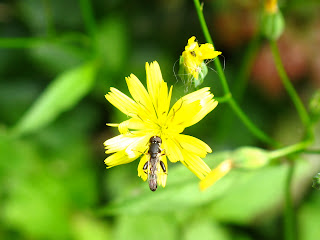
Since the end of July, large spiders with long legs have been running across carpets in the house, or falling in the bath. Being agile spiders that often react to disturbance by jumping and running very fast - as opposed to crouching or playing dead - these are spiders that tend to scare people. They are males of several species of the genus
Tegenaria. This guy fell in my bath a couple of nights ago and it has been the most compliant
Tegenaria I've had so far. He sat still on the white bowl while I got close to its palps, but despite getting good views, I still was unable to ID it.
The two most common species in the UK are
Tegenaria gigantea (=
duellica) and
T. saeva, and this male's palps could have been either. These closely related species differ in details of the female genitalia and of the morphology of the male palps, but their recent history is blurring the distinction between them in the north of England. Work by Peter Croucher, Geoff Oxford and colleagues from the University of York show that both spider species expanded north after the glaciations from refugia in the Iberian Peninsula. Through the vagaries of the colonisation process until recently, they had a mainly segregated distribution in the UK, with
T. gigantea in the east of the country and
T. saeva in the west.
Distribution in England and Wales of Tegenaria saeva and T. gigantea based on 10x10 km grid squares of standard maps (Ordnance Survey, the national mapping agency of Great Britain). Black squares, T. saeva; white squares, T. gigantea; grey squares, those containing both species. Spiders with intermediate morphologies are not included (figure from Croucher et al 2007).
In the south of the country, both species distributions meet in a narrow stable zone, in Dorset, where hybridisation appears not to be very common and when it happens results in high hybrid mortality. Since the 1970s, however, both species have expanded into Yorkshire and in this region they often occur in the same places and hybridise commonly, so that their species boundaries are falling apart and many morphologically intermediate forms are found. As Hull is in an area of high hybridisation, my inability to ID the spider might have more to do with my limitations, but there is a high chance there is no "pure"
T. gigantea and
T. saeva in this area any more, and that these house spiders are actually merging into one as they carry on colonising towards the north.
More information
Croucher, P., Oxford, G., & Searle, J. (2004). Mitochondrial differentiation, introgression and phylogeny of species in the Tegenaria atrica group (Araneae: Agelenidae) Biological Journal of the Linnean Society, 81 (1), 79-89 DOI: 10.1111/j.1095-8312.2004.00280.x
Croucher, P., Jones, R., Searle, J., & Oxford, G. (2007). CONTRASTING PATTERNS OF HYBRIDIZATION IN LARGE HOUSE SPIDERS (TEGENARIA ATRICA GROUP, AGELENIDAE) Evolution, 61 (7), 1622-1640 DOI: 10.1111/j.1558-5646.2007.00146.x









































